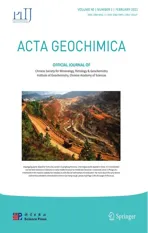Helium and argon isotope geochemistry of the Tibetan Qulong porphyry Cu-Mo deposit,China
2021-03-03KeqiangPengLiyanWuYongHuangKeJiang
Keqiang Peng•Liyan Wu •Yong Huang•Ke Jiang
Abstract The Qulong porphyry Cu–Mo deposit,generated in the Miocene post-collisional extension environment of the Gangdese Copper(Molybdenum)Metallogenic Belt,is one of the largest porphyry Cu deposits in China.This study reports the noble gas isotopic compositions of volatiles released from fluid inclusion reserved in pyrite from the Qulong deposit.3He/4He and 40Ar/36Ar ratios range from 0.54 to 1.015 Ra and 300–359,respectively.Concentrations of 4He and 40Ar range from 1.77 to 2.62×10-8 cm3 STP and 1.7–34×10-8 cm3 STP,respectively.The isotopic composition of noble gases indicates that the ore-forming fluids of the Qulong Cu–Mo deposit were a mixture of fluid containing mantle component,which is exsolved from the porphyry magma,and crustal fluid characterized by atmospheric Ar and crustal radiogenic He.Theδ34S values of pyrite and molybdenite range from-0.52‰ to 0.31‰,with an average of-0.12‰,indicating a magmatic origin.More mantle components were involved in the Cu–Mo deposit than in the Mo–Cu deposit in the Qulong-Jiama ore-district.
Keywords He and Ar isotopes·Sulfur isotope·Qulong Cu–Mo deposit·Ore-forming fluid·Tibet·China
1 Introduction
The Qulong porphyry Cu–Mo deposit(PCD),located in the east part of the Gangdese copper Metallogenic Belt,about 50 km east of Lhasa city,is one of the largest porphyry Cu deposits in China,with reserves of 10.6 Mt Cu@0.5% and 0.5 Mt Mo@0.03%(Xiao et al.2012).Many studies have been done on the geology(Yang 2008;Yang et al.2009;Qin et al.2014),petrology(Hu et al.2015;Mo et al.2006;Yang et al.2011),mineralization(Meng et al.2006),geochronology(Meng et al.2003;Wang et al.2006;Li et al.2017a,b),magmatic-hydrothermal evolution(Li et al.2017a;Yang et al.2005,2009),and thermal history(Zhao et al.2016;Zhou et al.2019)of the Qulong deposit.Approximately the same S and Pb isotope compositions of sulfide and ore-related porphyry show that the ore-forming materials are mainly from the porphyry magma(Qu et al.2002,2007;Meng et al.2006).However,the contribution of the mantle is not clear.
Among the noble gases,He and Ar are the most efficient for tracing the sources of ore-forming fluids because of the significant difference of isotopic compositions between end members.3He/4He ratio of the upper mantle is 7–9 Ra(Graham,2002,where Ra is the atmospheric3He/4He ratio and 1 Ra=1.39×10-6),while the3He/4He ratio of crustal rocks is 0.01–0.05 Ra(O’Nions and Oxburgh 1983),40Ar/36Ar ratio of air is 295.5,while mantle-derived Ar is dominated by radiogenic40Ar,with40Ar/36Ar>40,000,and crustal rocks have40Ar/36Ar≥45,000 due to radiogenic and nucleogenic Ar produced in the crust.Therefore,40Ar/36Ar ratios are sensitive to trace the addition of meteoric fluid from crust or mantle Ar,and the3He/4He ratios can distinguish the involvement of mantle He(Stuart et al.1995;Hu et al.1998,1999,2004,2009,2012).Thus,He and Ar isotopes can provide a unique insight into the origin and evolution of ore-forming fluids(Burnard et al.1999;Burnard and Polya 2004;Davidheiser-Kroll et al.2014;Hu et al.2012;Kendrick et al.2001;Stuart et al.1995;Wu et al.2018).
In this study,He and Ar isotopes of fluid inclusions in pyrites and S isotopic compositions of pyrite and molybdenite were obtained to constrain the origin of the oreforming fluids of the Qulong PCD.
2 Geological background
The Qulong PCD is situated in the southern part of the Lhasa Terrane,which is bordered by the Bangong–Nujiang suture(BNS)in the north and the Indus–Yarlung suture(IYS)in the south(Fig.1),and is composed mainly of the Paleozoic to Mesozoic marine clastic sedimentary rocks and volcanic rocks,and the Paleozoic to Cenozoic magmatic rocks,with the Precambrian basement known as the Nyainqeˆntanglha Group(Yang et al.2009;Zhang et al.2014).The Lhasa terrane and is divided into the northern,central,and southern Lhasa subterranes,separated by the Shiquan River–NamTso Me´lange and the Luobadui–Milashan faults(Zhang et al.2014).According to the zircon εHfvalues and relevant Hf model ages,the south and north Lhasa subterranes are dominated by juvenile crustal blocks while the central Lhasa subterrane is characterized with ancient and locally reworked crust(Hou et al.2015).
The southern Lhasa subterrane mainly consists of Gangdese volcanic-magmatic arc,dominated by the extensively distributed Early Cenozoic Linzizong volcanic succession and the Cretaceous-Tertiary granitic intrusions(Pan et al.2004,Pan 2006;Zhu et al.2008,2013).The India–Asia collision initiated along the Indus—Yarlung Zangbo suture at around 65–55 Ma(Rowley 1996;Mo et al.2003;Wang et al.2003;Ding et al.2005;Dong et al.2006;Pan 2006;Zhu et al.2011,2013),followed later by the subduction of India continental plate at around 35 Ma(Ali and Aitchison 2008;Wang et al.2014).The subsequent break off of the denser India plate beneath the Asia plate at 25–15 Ma(Aitchison et al.2007;Van Hinsbergen et al.2012),which triggered the generation of the Oligo–Miocene magmatic rocks associated with porphyry Cu-Mo deposits along the of the Gangdese porphyry copper belt(Hou et al.2009;Van Hinsbergen et al.2012;Wang et al.2014;Li et al.2017a,b),of which the Qulong deposit is the largest(Zheng et al.2004;Qin et al.2014).The porphyry magmatism culminated at 16±1 Ma,ranging from 26 to 13 Ma,and the molybdenite Re–Os ages of the mineralization are from 17 to 14 Ma(Hou et al.2015 and the references therein).
The central Lhasa subterrane is composed of many Miocene porphyry(20–16 Ma)Mo–Cu deposits,such as the Bangpu porphyry Mo–Cu deposit.Most of those deposits are situated along the southern margin and spatially associated with the reworked ancient crustal block(Hou et al.2015).Sr–Nd isotope data indicate that those porphyry Mo deposits are possibly formed by the melting of an ancient lower crust with minor mantle component contribution(Hou et al.2011,2015).
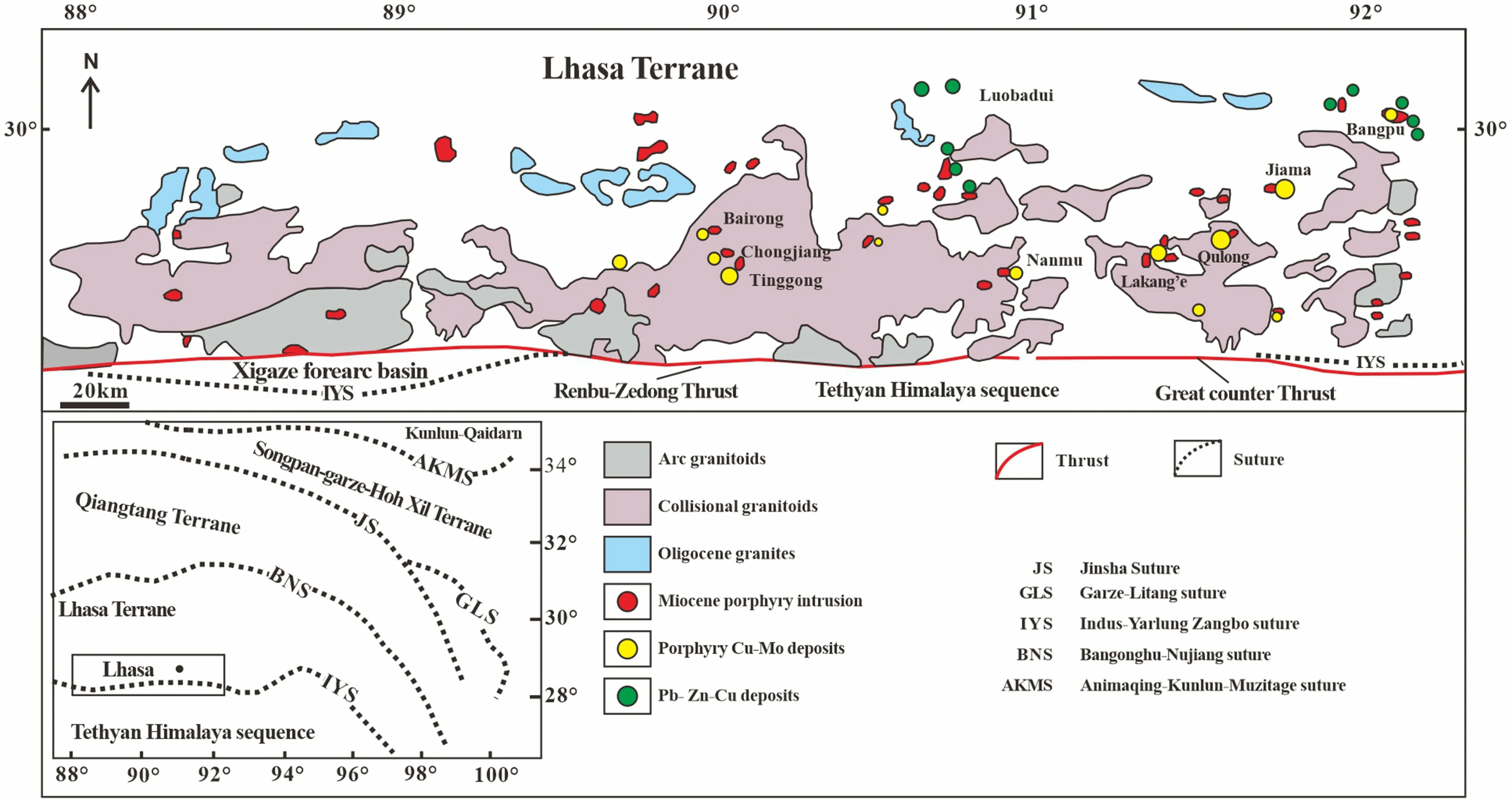
Fig.1 Tectonic setting and geological map of the Gangdese Porphyry Copper Belt.Modified from Li et al.(2017b)
3 Deposit geology
The outcrop layer of Jurassic Yeba Formation is widely distributed at the district of Qulong deposit,characterized by intermediate–acid volcanic rock,pyroclastic rock,and a few sedimentary rocks interbedded(Yang et al.2009;Qin et al.2014).The intrusive rocks at Qulong deposit are mainly the mid-Miocene intermediate–acid complex(Fig.2),including the Rongmucuola pluton,the P porphyry,and the X porphyry.The mid-Miocene Rongmucuola pluton intruded into the Yeba Formation and the Jurassic dacite–rhyolite porphyry at 17.142±0.014 Ma(Li et al.2017b),which hosts the majority of the Cu–Mo in the Qulong deposit(Li et al.2017a).It varies gradually from granodiorite to biotite monzogranite in composition(Yang et al.2009;Zhao et al.2016),containing plagioclase,K–feldspar,quartz,amphibole,and biotite in variable percentages(Zhao et al.2016;Li et al.2017b).The P porphyry(monzogranite porphyry),which was emplaced into the center of the western Rongmucuola pluton at 16.009±0.016 Ma(Li et al.2017b),is the syn-ore porphyry at the Qulong deposit(Yang et al.2009;Hu et al.2015;Zhao et al.2016)and is composed of plagioclase(15 vol%),quartz(5 vol%),K–feldspar(5 vol%)and biotite(3 vol%)as phenocrysts,with the quartz and feldspar,dominated the groundmass(Yang et al.2009;Li et al.2017a).The X porphyry(monzogranite porphyry),which crosscut both the western Rongmucuola pluton and the P porphyry,share a similar composition and texture with the P porphyry except that it contains less biotite.
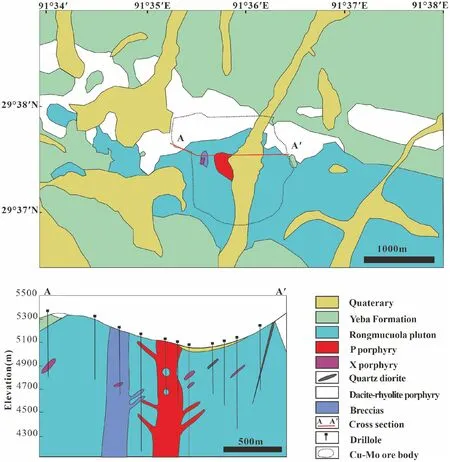
Fig.2 Geological map a of the Qulong Cu–Mo porphyry deposit with cross-sections,b.Simplified and revised from Zhao et al.(2016)
The mineralization of Qulong PCD is mainly hosted in the western Rongmucuola pluton and associated with the potassic alteration minerals assemblages.The Re–Os age of molybdenite is 16.41±0.48 Ma(Meng et al.2003),and recently Li et al.(2017b)reported new high precision Re–Os age of 16.126±0.008 Ma and 15.860±0.010 Ma.The ore minerals at the Qulong deposit are dominated by pyrite,chalcopyrite and molybdenite(Fig.3a,b,c)with minor bornite,galena and sphalerite(Fig.3d),the mineralization occurs as veins(Fig.3a,b)or disseminated.Most of the chalcopyrite and molybdenite are presented in veins that consist of quartz,pyrite and minor anhydrite(Fig.3b).Chalcopyrite is either of disseminated structure that associated with biotite alteration,or occurs as veinlets with an alteration halo of chlorite–sericite.Molybdenite generally filled in the central or margin of quartz veins.
Fluid inclusion studies and H,O isotopic composition of Qulong deposit indicate that the ore–forming fluid of the early stage mineralization and alteration are exsolved from magma at the temperature of 550–650 °C with moderate salinity(9% NaCl),and mixed with meteoric water later(Li et al.2018;Yang and Hou 2009).The S and Pb isotopes of copper–bearing porphyries and ore minerals from the deposit suggest that the ore–forming materials were mainly from magma(Meng et al.2006).
4 Sampling and analytical methods
The samples used in this study were collected from drill cores of the Qulong Cu–Mo deposit(Fig.3).Pure pyrite and molybdenite were hand-picked from the crushed ore under a binocular microscope.The measurements were carried out using a GV 5400 mass spectrometer at the Institute of Geochemistry,Chinese Academy of Sciences(IGCAS),Guiyang,China.The sensitivities of the GV5400 for He and Ar were 3.9725×10-4A/Torr and 1.1018×10-3A/Torr,respectively.Pure sulfide grains(1–2 g with sizes of 0.5–1.5 mm)were ultrasonically cleaned in alcohol before being loaded online into vacuum crusher buckets.The samples were baked at 120–150 °C in the crusher buckets for ca.24 h to remove adhered atmospheric gases.The gases were released by sequential crushing of the pyrite grains in high–vacuum conditions.He and Ar isotopic compositions and abundances were calibrated against pipettes of 0.1 cm3STP air(5.2×10-7cm3STP4He and 9.3×10-4cm3STP40Ar).Procedural blanks were<2×10-10cm3STP4He and(2–4)×10-10cm3STP40Ar.The detailed analytical procedures are described in Hu et al.(2012).
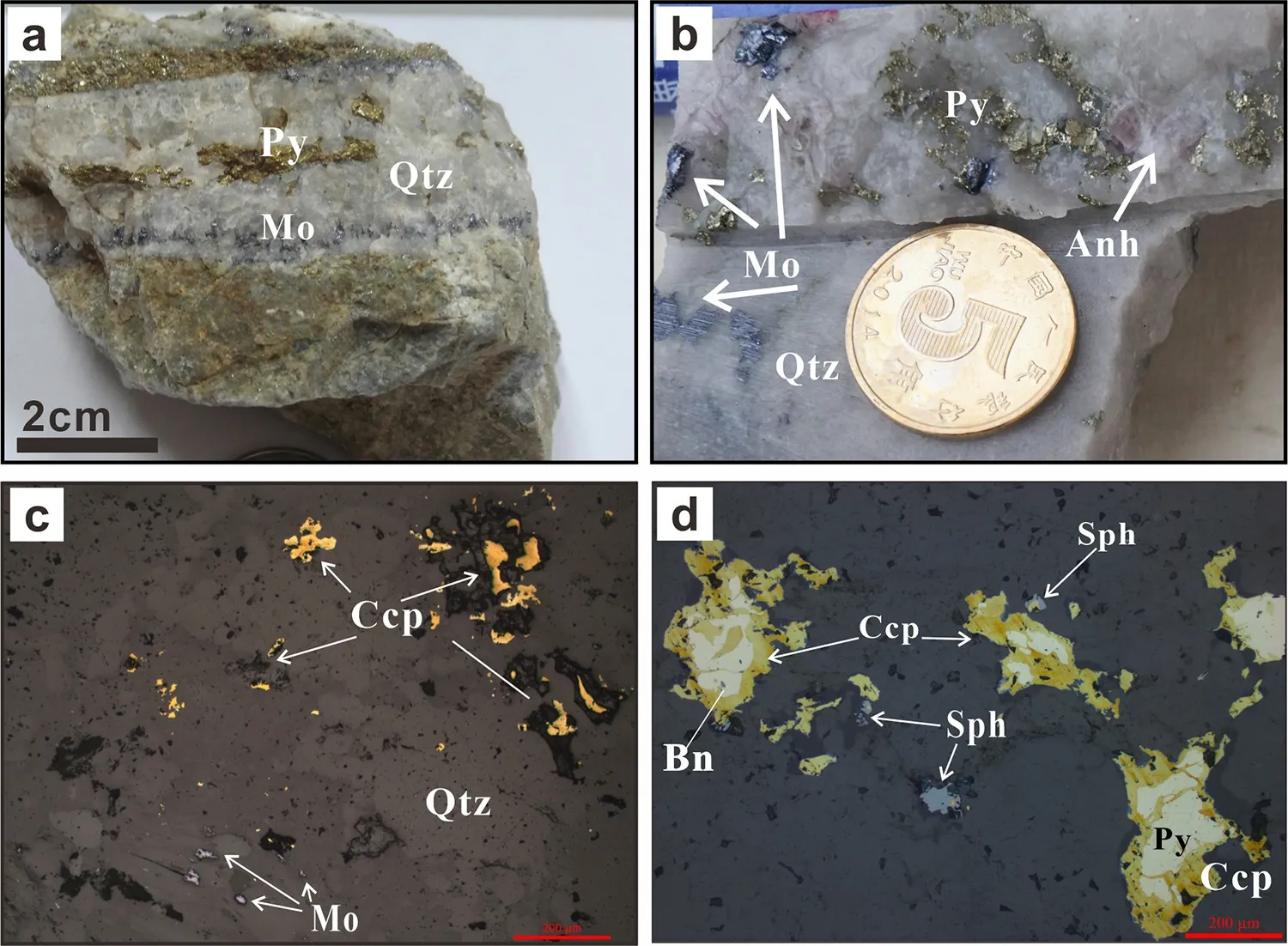
Fig.3 Photographs of hand specimens and micrographs from the Qulong PCD.a Sample of Qtz-Py-Mo vein;b sample of Qtz-Py-Mo-Anh vein;c micrograph of Qtz-Mo-Ccp assemblage;d micrograph of Ccp-Bn-Sph-Py assemblage.Abbreviation:Anh-anhydrite,Bn-bonite,Ccp-chalcopyrite,Mo-molybdenite,Py-pyrite,Sph-sphalerite,Qtz-quartz
The sulfur isotope composition of the sulfide minerals was determined using a Thermo MAT253 continuous flow isotope ratio mass spectrometer coupled to an elemental analyzer(EA–IRMS)at the IGCAS.Measurements are reported using standardδ–notation relative to V–CDT international standard.The reproducibility of replicate analyses of the IAEA international standards:IAEA S1(-0.3‰),IAEA S2(+22.62‰),and IAEA S3(-32.49‰)yields a precision that is better than 0.2 ‰(1σ).
5 Results
The He and Ar isotopic compositions released from the fluid inclusion of pyrite crystals are listed in Table 1 and Figs.4,5,and 6.The concentrations of3He vary from 4.68 to 14.17×10-15cm3STP/g,and40Ar concentration range from 8.79 to 154.72×10-9cm3STP/g.The3He/4He ratios vary from 0.54 to 1.02 Ra(Ra:the3He/4He ratio of air,1 Ra=1.39×10-6),and the40Ar/36Ar ratio varies from 300 to 359.δ34S range from-0.52 to 0.31 ‰,with an average of-0.12 ‰.
6 Discussion
6.1 Source of ore-forming fluids using He,Ar,and S isotopes
Many studies have demonstrated that pyrite is capable of trap and preserve noble gases(Stuart et al.1995;Hu et al.1998,2004,2009,2012;Burnard et al.1999),and helium and argon trapped in fluid inclusion will not lose extensively within 100 Ma(Burnard et al.1999).The ratios of3He/4He and40Ar/36Ar will not change even if the trapped He and Ar lost partially(Hu et al.1997,2004,2012;Ballentine and Burnard 2002).Since pyrite is not Libearing mineral,there is no helium produced by the nuclear decay of lithium.Contamination of cosmogenic3He can also be eliminated since all of the pyrites of this study are collected from drill core of which the depths are more than 50 m.U and Th concentrations in hydrothermal fluids are commonly low(Hu et al.2012;Norman and Musgrave 1994),therefore the radiogenic4He produced in situ in fluid inclusions is also negligible(Hu et al.2012).The impact of40Ar produced by the decay of40K in the mineral lattice should be negligible because of the low diffusivity of Ar in pyrite(York et al.1982;Smith et al.2001)and the extremely low concentration of K in pyrite(York et al.1982).The radiogenic40Ar produced in pyrite fluid inclusions is also negligible,due to the high proportion(more than 80%,see the Discussion in 5.1.2)of atmospheric Ar.Therefore,the measured He and Ar isotopic compositions of pyrite samples could basically represent the features of the ore–forming fluids of Qulong porphyry Cu–Mo deposit.
6.1.1 Helium
The3He/4He ratios of pyrites from the Qulong PCD are between 0.54 and 1.01 Ra(Table 1;Fig.5).By calculating the F4He values,which is defined as4He/36Ar value of the sample relative to the atmospheric4He/36Ar value of 0.1655(Kendrick et al.2001),we can determine the atmospheric Helium contribution.The F4He values of Qulong PCD are between 300 and 1920(Table 1),indicating that4He of the Qulong PCD is 300–1900 times higher than the atmospheric concentration.This means that the atmospheric He contribution is negligible in the mineralizing fluids.The3He/4He ratios of the Qulong PCD are significantly higher than the crustal fluid value(0.01–0.05Ra)and lower than the mantle components value(6–9 Ra),indicating that both mantle and crustal components were involved in the hydrothermal fluids of the Qulong PCD.The3He/4He and40Ar/36Ar ratios of Qulong PCD is plotted on the trend line(Fig.5)modeled by binary mixing between a high3He/4He(1.23 Ra),high40Ar/36Ar fluid containing mantle component,and a crustal fluid with atmospheric40Ar/36Ar and radiogenic4He(Burnard et al.1999).The Qulong porphyry deposit is spatially and temporally associated with monzogranite porphyry(P porphyry)(Meng et al.2003;Qin et al.2014).S,Pb,H,and O isotopic features of the copper-bearing porphyries and ore minerals from the Qulong deposit show that ore-forming fluid and materials were mainly derived from the magma(Meng et al.2006;Yang and Hou 2009).Therefore,the high3He/4He ratio mantle end-member in the ore-forming fluid was likely to be exsolved from the monzogranite porphyry(P porphyry)magma.The3He/4He ratio(1.02 Ra,the maximum value measured in this study)of the mantle end-member is much less than the typical sub-continental mantle value(~6 Ra),indicating that the mantle helium from mantle-derived magma was diluted by incorporating radiogenic helium within the parental magma of the associated porphyry before helium was released into the hydrothermal system(Hu et al.2012).This is consistent with the conclusion that monzogranite porphyry magma was generated by partial melting of the thickened lower–crust under the Tibetan orogen with the input of mantle components(Meng et al.2006;Yang et al.2015).
We can use the3He/4He ratios to calculate the proportion of mantle and crustal components based on binary mixing.The proportion of mantle or crustal4He can be calculated using the following equation(Burnard et al.1999):


δ34S(‰)40Ar*/4He(10-3)F4He 36Ar/3He 3He/4He(Ra)3He(10-14 cm3STP)-0.52 0.24-0.05-0.19-0.25-0.32-0.48 0.31 0.21 1271 325 1843 15.1 214 303 561 126 1922 130 26515 9283 33,757 2250 36,369 0.54±0.04 0.83±0.05 1.02±0.06 1.01±0.06 0.91±0.06 1.95±0.12 3.04±0.14 3.08±0.14 2.52±0.12 2.25±0.12 Table 1 He,Ar and S isotopic compositions of sulfidesfrom the Qulong porphyry deposit 4He(10-8 cm3STP)40Ar/36Ar 36Ar(10-10 cm3STP)40Ar(10-8 cm3STP)Weight(g)Mineral Sample 2.60±0.08 2.62±0.08 2.18±0.07 1.81±0.05 1.77±0.05 359±5 326±5 334±3 300±15 300±3 5.16±0.07 2.82±0.05 10.4±0.01 0.57±0.29 8.18±0.10 18.6±0.07 9.2±0.04 34.8±0.14 1.7±0.01 24.6±0.10 4.16 3.11 2.52 1.94 1.59 Pyrite Pyrite Pyrite Pyrite Pyrite Pyrite Molybdnite Pyrite Molybdnite zk816-1 ql1513 zk1616-1 zk816-2 ql1518 zk816-3 zk816-3 QLD2 QLD2 Errors quoted are at the 1σconfidence level 40Ar*is the non-atmospheric Ar,40Ar*=40Ar-[36Ar×295.5]F4He=(4He/36Ar)sample/(4He/36Ar)air,(4He/36Ar)air=0.1655
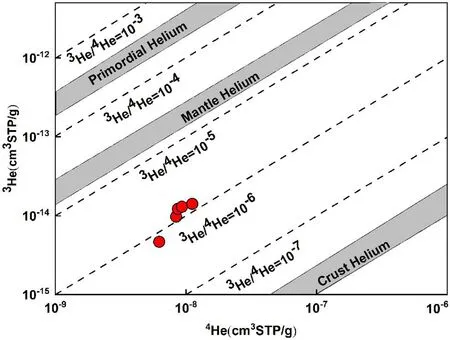
Fig.4 Helium isotopes data of volatiles released from fluid inclusion of pyrite in the Qulong porphyry Cu–Mo deposit(modified from Mamyrin and Tolstikhin 1984)
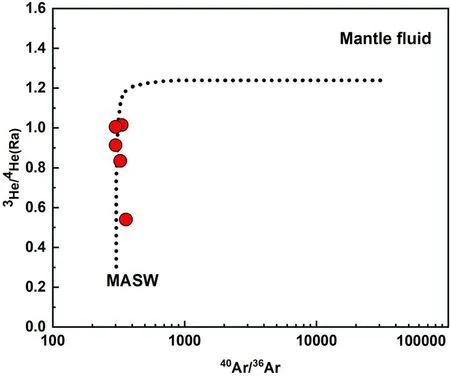
Fig.5 3He/4He versus 40Ar/36Ar for pyrite from the Qulong Cu–Mo deposit.He and Ar isotopic compositions of Qulong Cu–Mo deposit plotted on the trend line modelled by binary mixing between a‘magmatic fluid’’with 3He/4He=1.23 Ra,40Ar/36Ar≥40,000 and a crust fluid with 40Ar/36Ar=295.5,3He/4He=0.01 Ra.Modified from Burnard et al.(1999)
The total4He is measured from the samples;since3He are mainly from mantle so the measured3He could be regarded as mantle3He roughly.The mantle4He/3He is about 1.19×105(Burnard et al.1999).According to the calculation,around 8%–90%4He was derived from the crust,corresponding to a mantle contribution of around 10%–16%.
6.1.2 Argon
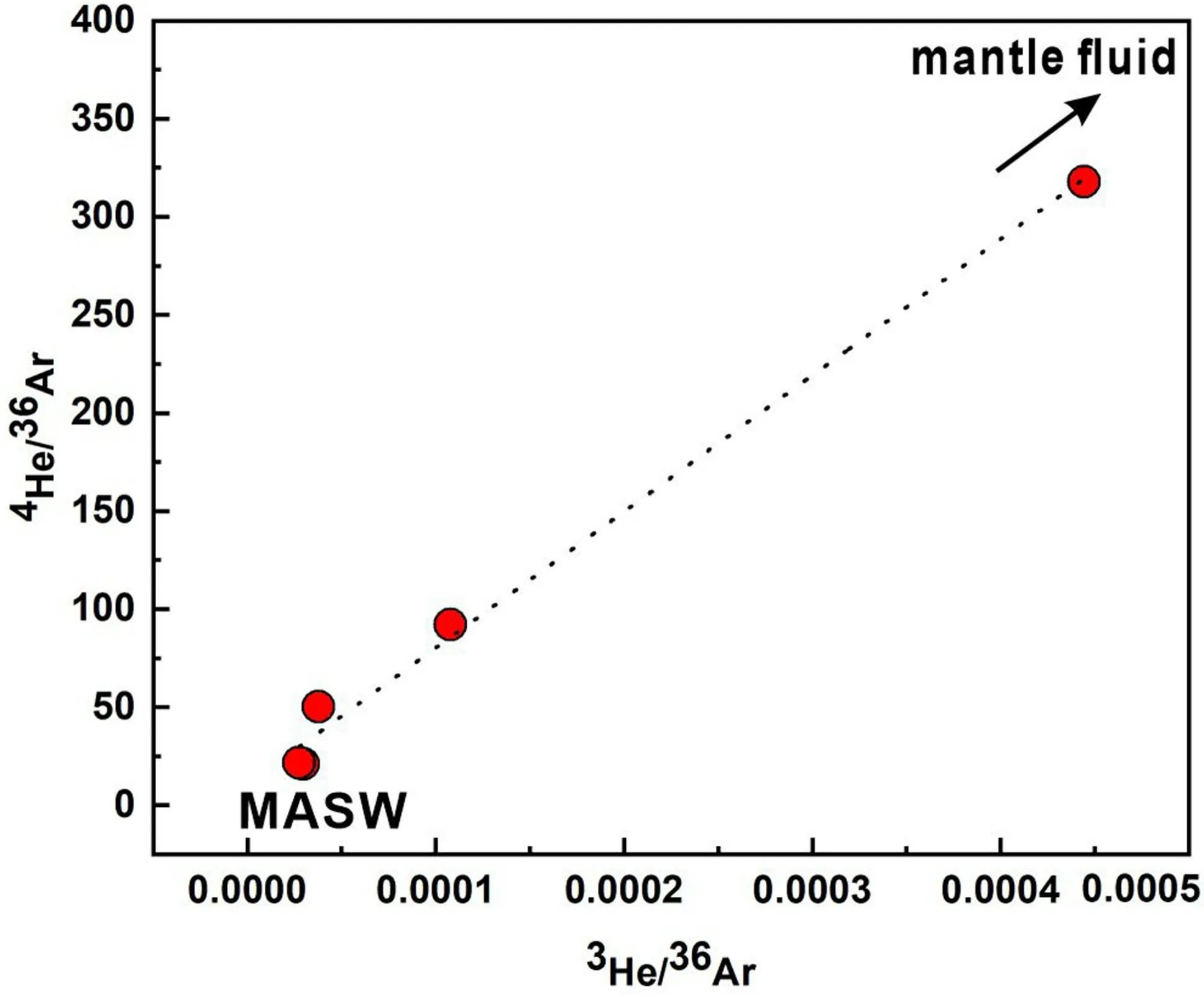
Fig.6 3He/36Ar versus 4He/36Ar for pyrite from the Qulong Cu–Mo deposit.The linear correlation is obtained by least squares regression:4He/36Ar=10.7+694,978×3He/36He,R2=0.99
The measured40Ar/36Ar of Qulong deposit range from 300 to 359,which are higher than the value of air-saturated water(ASW,40Ar/36Ar=295.5)and indicate the presence of excess40Ar*derived from the mantle or crustal components.We can calculate the proportion of40Ar*with the following equation(Kendrick et al.2001):

Estimated40Ar*range from 1.6%to 17%,with an average of 8.4%,which means that the proportion of air derived Ar is 83%–98.3%,with an average of 91.6%.Therefore,the40Ar of mineralization fluid of Qulong is dominated by atmospheric Ar that is commonly provided by the meteoric water.Since both3He and36Ar are unradiogenic,the3He/36Ar ratio of meteoric water before mixing with mantle fluid is a constant value of 5×10-8(Burnard et al.1999).By extrapolating the trend in Fig.6 to pure ASW(3-He/36Ar=5×10-8)generate a4He/36Ar value of 10.7,which is much higher than that of ASW(0.46,Ozima and podosek 2002),indicating that the ASW was modified by the addition of radiogenic4He.Therefore,a crustal fluid end member consists of ASW modified by the crustal radiogenic4He,called modified air-saturated water(MASW),is considerable.Two samples have high40Ar*/4He ratios(Fig.7)that much higher than that of the mantle and crust production ratios(0.5 and 0.2 respectively).The higher40Ar*/4He ratios may cause by the addition of a third source for40Ar*or loss of He.The measured4He values are an order of magnitude lower than other deposit in this area(such as Bangpu deposit,Wang et al.2015),therefore the higher40Ar*/4He ratios may because of boiling of the ore-forming fluid,which causes the enrichment of less volatile heavier noble gases in the residue fluid and the lighter and more volatile noble gases enriched in the vapor phase(Kendrick et al.2001).This is consistent with the fluid inclusion studies that boiling occurred in the early stage fluid(Yang and Hou 2009).
6.1.3 Sulfur
Theδ34S values of sulfides from the Qulong Cu–Mo deposit have a narrow range(-0.52 ‰–0.31 ‰)and are within the range of the magmatic value(0 ‰±2 ‰;Kyser 1990),indicating a magmatic origin.This may due to the low concentration in the MASW compared with the magmatic hydrothermal fluid.In addition,the country rocks of the deposit are mainly volcanic rocks so that the contamination of sulfur from these rocks would not change the S isotopic compositions of magma.
6.2 Comparison between porphyry Cu and Mo deposits in the Gangdese belt
Bangpu is a Mo-dominant with Cu as a by-product deposit in Qulong–Jiama ore–district in Gangdese metallogenic belt.The3He/4He ratios of Bangpu(0.12–0.36 Ra)are lower than that of Qulong deposit(0.54–1.02 Ra),and the estimated proportion of crustal derived He for the Bangpu deposit and the Qulong deposit is 94%–98% and 84%–90%,respectively,which means Qulong deposit contains more mantle components compared with the Bangpu deposit,which is consistent with the results of Pb isotopes(Yao et al.2002;She et al.2005;Li et al.2012;Zhou et al.2012;Meng et al.2006).This is coincident with the fact that the mineralization of the Qulong deposit is due to the refertilization of Cu in the juvenile lower crust with significant mantle components,whereas the Bangpu porphyry Mo deposit is related to remelting of an ancient lower crust with minor mantle component contributions(Hou et al.2013,2015).

Fig.7 40Ar*/4He versus 3He/4He for sulfides from the Qulong Cu–Mo and Bangpu Mo–Cu deposits in Gangdese metallogenic belt.Data of Bangpu porphyry Mo deposit collected from Wang et al.(2015)
7 Conclusion
The ore-forming fluids of the Qulong Cu–Mo deposit were a mixture of a fluid containing mantle components and a crustal fluid containing atmospheric Ar and crustal radiogenic4He.The former was probably exsolved from the orebearing porphyry magma,and the later was meteoric water interacted with crustal rocks,therefore modified by the addition of radiogenic4He.δ34S values of sulfides from Qulong deposit indicate that the sulfur is of magmatic origin and crustal fluid does not supply significant S to the ore-forming system.Mantle-derived components played an important role in the formation of Miocene deposits in the Gangdese metallogenic belt.Cu–Mo deposit contains much more mantle components compared with the Mo–Cu deposit.
AcknowledgementsWe wish to express our thanks to Dr.Guohao Jiang for He and Ar isotope analyses and Dr.Jing Gu for S isotope analysis.We thank Dr.Jingjing Zhu and an anonymous reviewer for their helpful comments which have improved the manuscript.This work was financially supported by the Strategic Priority Research Program(B)of Chinese Academy of Sciences(XDB18000000),National Natural Science Foundation of China(41773048)and The Western Young Scholars Project(Class A)of Chinese Academy of Sciences.
Compliance with ethical standards
Conflict of interestThe authors declare that there is no conflict of interest.
杂志排行
Acta Geochimica的其它文章
- Early Silurian Wuchuan-Sihui-Shaoguan exhalative sedimentary pyrite belt,South China:constraints from zircon dating for K-bentonite of the giant Dajiangping deposit
- Niobium-tantalum oxide minerals in alluvial placer deposits from the Ngoura area,East-Cameroon
- Development of a 100 MPa water-gas two-phase fluid pressurization device
- Translocation and distribution of mercury in biomasses from subtropical forest ecosystems:evidence from stable mercury isotopes
- Neoproterozoic highly fractionated I-type granitoids of Shillong Plateau,Meghalaya,Northeast India:geochemical constraints on their petrogenesis
- Coprecipitation of metal ions into calcite:an estimation of partition coefficients based on field investigation
